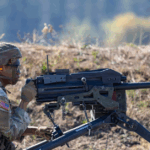
The Army plans to stick with its Cross-Functional Team (CFT)-led approach to future system development beyond 2035, the head of Futures Command said Tuesday, as the service looks to take on new modernization initiatives in areas such as artificial intelligence and logistics. Gen. Mike Murray told reporters the service is conducting “futures studies” that will inform how the eight existing CFTs, which work on developing the Army’s current group of more than 30 signature systems, may need new titles or…

 By
By 











